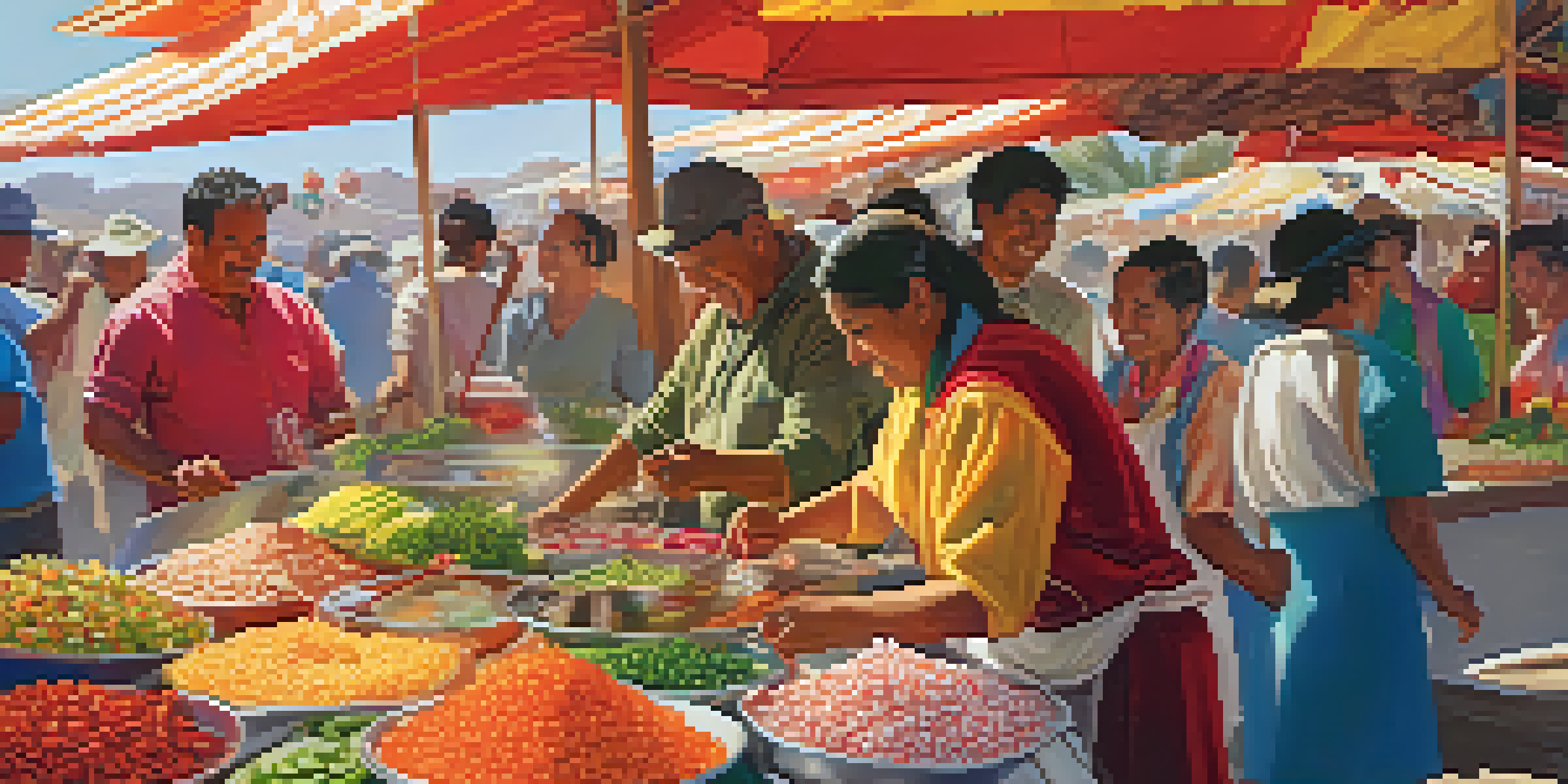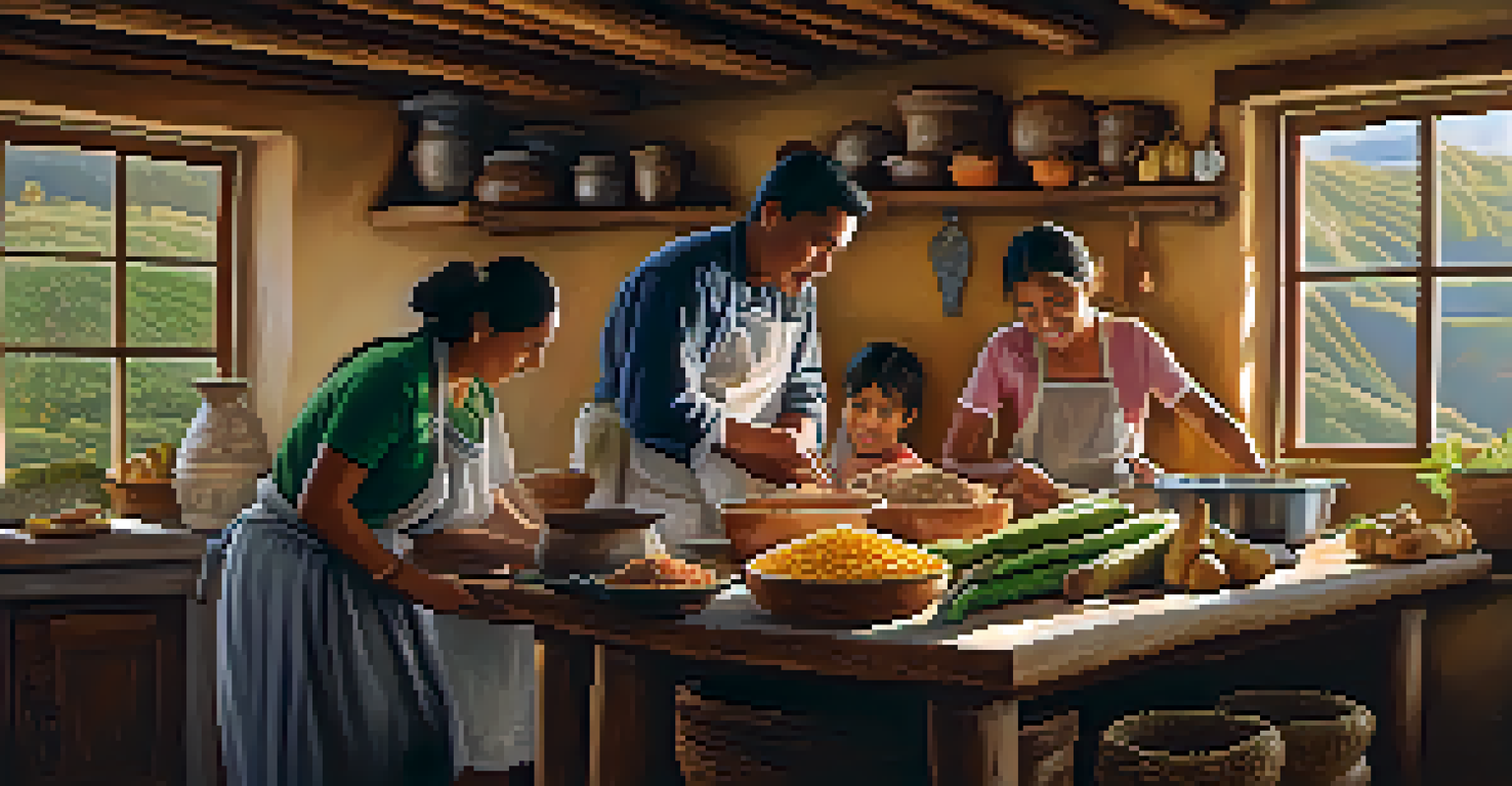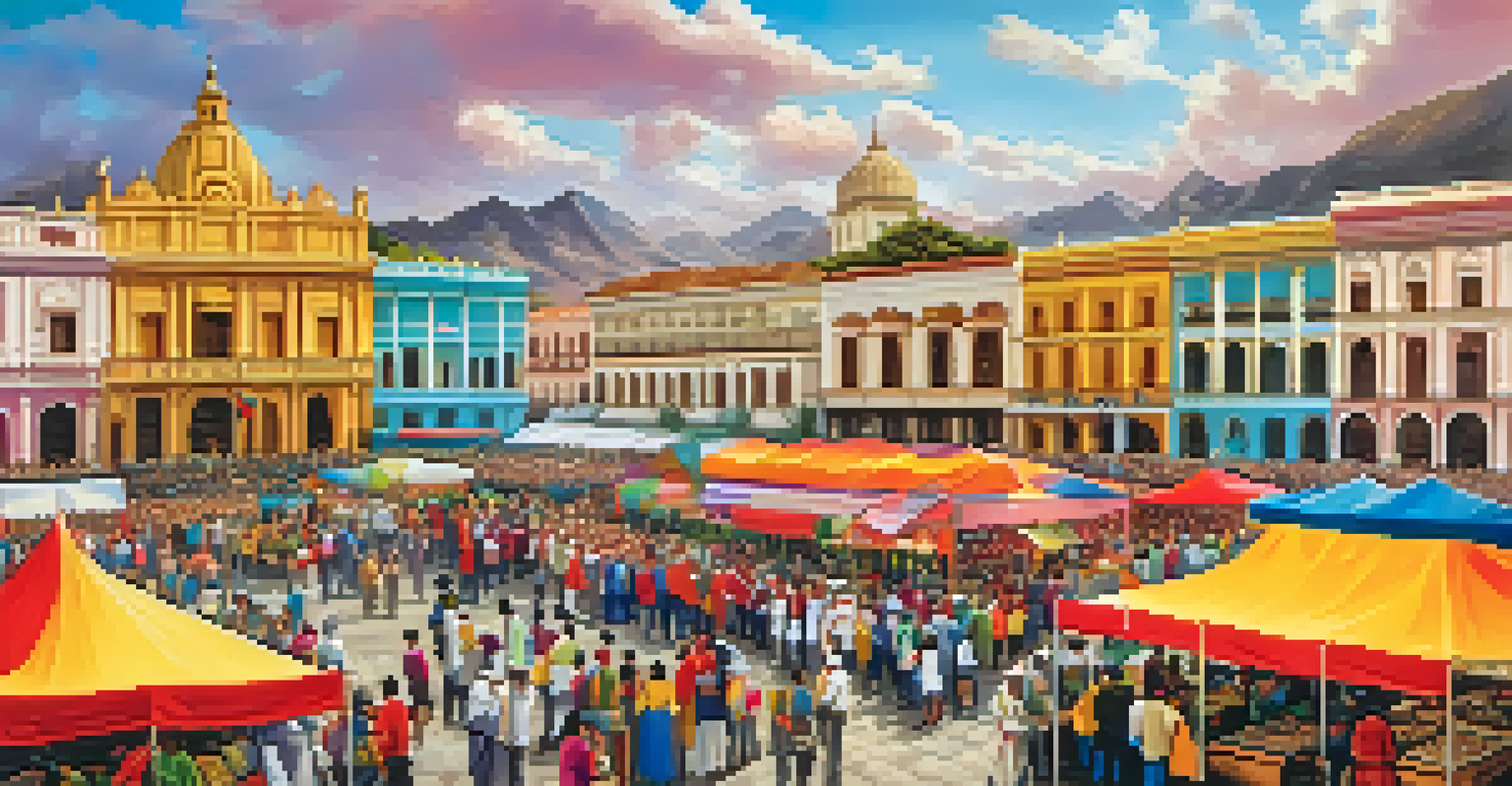The Role of Culinary Traditions in Peruvian Festivals

The Importance of Culinary Heritage in Peru
Peru boasts a rich tapestry of culinary traditions that are deeply woven into its festivals. Each dish tells a story, reflecting the country's diverse cultural influences, from indigenous communities to Spanish colonization. This culinary heritage is not just about sustenance; it's a way to connect with history and community.
Food is our common ground, a universal experience.
During festivals, traditional foods such as ceviche, pachamanca, and anticuchos take center stage, showcasing Peru's unique ingredients and cooking methods. These dishes are often prepared with family and friends, reinforcing bonds and shared experiences. The act of cooking together becomes a celebration in itself.
Moreover, culinary traditions serve as a medium for cultural expression and identity. When families gather to prepare traditional meals, they pass down recipes and stories, ensuring that their heritage remains alive for future generations. This intergenerational exchange is crucial in maintaining Peru's rich culinary legacy.
Key Festivals Celebrating Peruvian Cuisine
Several festivals in Peru highlight the integral role of food in cultural celebrations. One prominent example is Inti Raymi, the Festival of the Sun, where ancient rituals are performed alongside traditional meals. Participants enjoy dishes that honor the earth and harvest, emphasizing the connection between culinary practices and spirituality.

Another noteworthy event is the Mistura Food Festival, which showcases Peru's gastronomic diversity. Chefs and food producers gather to celebrate local ingredients, offering a feast for the senses. This festival not only highlights traditional recipes but also promotes innovation in Peruvian cuisine, attracting food lovers from around the globe.
Culinary Heritage Connects Communities
Peru's culinary traditions serve as a vital link to its history and cultural identity, celebrated through communal cooking during festivals.
During these festivals, food becomes a medium for storytelling and cultural pride. Attendees savor flavors that evoke memories and emotions, linking them to their roots. This celebration of culinary traditions fosters a sense of community and belonging, making the experience even more meaningful.
Traditional Ingredients and Their Significance
The ingredients used in Peruvian cuisine are often tied to the land and the culture of the people. Staples like potatoes, corn, and quinoa are not just food items; they represent a way of life and agricultural heritage. These ingredients are prominently featured in festival dishes, highlighting their importance to the Peruvian identity.
Cooking is like love. It should be entered into with abandon or not at all.
For instance, potatoes hold a special place in Peruvian cuisine, with over 4,000 varieties grown in the Andes. During festivals, dishes made with potatoes, like causa and papa a la huancaína, are celebrated for their versatility and flavor. This showcases the deep relationship between the Peruvian people and their agricultural practices.
Similarly, the use of fresh seafood in dishes like ceviche reflects Peru's coastal geography. Festivals often highlight seasonal catches, reinforcing the connection between community, environment, and cuisine. Such practices encourage sustainable fishing and respect for marine resources, further enriching the cultural narrative.
Culinary Rituals and Their Symbolism
Culinary rituals during festivals often carry deep symbolic meanings that resonate with the participants. For example, the preparation of pachamanca, a traditional dish cooked underground, honors Pachamama, or Mother Earth. This method of cooking is not only a culinary technique but also a spiritual act of gratitude and respect.
These rituals can vary across regions, reflecting local customs and beliefs. In some areas, families may perform specific prayers or songs while cooking, reinforcing the idea that food is sacred. This blend of gastronomy and spirituality creates an enriching experience that transcends mere sustenance.
Festivals Showcase Diverse Cuisine
Events like Inti Raymi and Mistura highlight the integral role of food in Peruvian celebrations, blending traditional dishes with modern culinary innovations.
Moreover, the communal aspect of these rituals fosters a sense of unity among participants. As families and friends gather to prepare and share meals, they reinforce social ties and create lasting memories. This sense of togetherness is what makes Peruvian festivals truly special, with food at the heart of the celebration.
Modern Influences on Traditional Peruvian Cuisine
While traditional culinary practices are vital, modern influences have also shaped Peruvian cuisine, especially during festivals. Chefs experiment with fusion dishes that blend global flavors with local ingredients, creating a dynamic culinary scene. This innovation attracts a younger audience and keeps the traditions alive in a contemporary context.
For instance, many festivals now feature gourmet takes on classic dishes, showcasing the versatility of Peruvian ingredients. This evolution highlights how culinary traditions can adapt and thrive, ensuring that they remain relevant in today's fast-paced world. It's a beautiful dance between honoring the past and embracing the future.
However, this modernization does not overshadow the original culinary practices. Instead, it complements them, allowing for a broader appreciation of Peru's diverse food culture. As chefs continue to push boundaries, they invite new generations to explore their culinary heritage while celebrating the essence of their traditions.
The Role of Culinary Tourism in Festivals
Culinary tourism has become a significant aspect of Peruvian festivals, drawing food enthusiasts from around the world. Travelers seek authentic experiences that allow them to indulge in local flavors and participate in traditional cooking practices. This interest not only boosts the economy but also fosters cultural exchange.
During festivals, many local chefs and home cooks offer workshops and tastings, creating opportunities for visitors to learn about the cuisine firsthand. This hands-on experience enhances the appreciation for Peruvian culinary traditions, as tourists gain insight into the stories behind each dish. It's a win-win for both locals and visitors.
Culinary Tourism Enhances Experiences
Culinary tourism during festivals fosters cultural exchange and appreciation for Peruvian cuisine, benefiting both locals and visitors alike.
Moreover, this influx of culinary tourism encourages the preservation of traditional recipes and techniques. As chefs showcase their culinary heritage, they inspire pride within their communities. This shared passion for food helps to sustain the vibrant culture that defines Peru, making culinary festivals a vital part of the country's identity.
Conclusion: Celebrating Culinary Traditions in Peru
In conclusion, culinary traditions play a pivotal role in the vibrant festivals of Peru. These celebrations go beyond food; they encapsulate history, culture, and community. Each dish served during these festivals is a reminder of the rich heritage that shapes Peruvian identity.
As Peru continues to embrace culinary innovation, the balance between tradition and modernity remains vital. Festivals like Inti Raymi and Mistura not only celebrate the past but also pave the way for the future of Peruvian cuisine. This blend of old and new creates a dynamic food culture that is both exciting and deeply rooted.

Ultimately, the role of culinary traditions in Peruvian festivals is a testament to the power of food as a unifying force. Whether through rituals, communal meals, or modern interpretations, these culinary practices foster connections and create lasting memories, ensuring that the spirit of Peru thrives for generations to come.